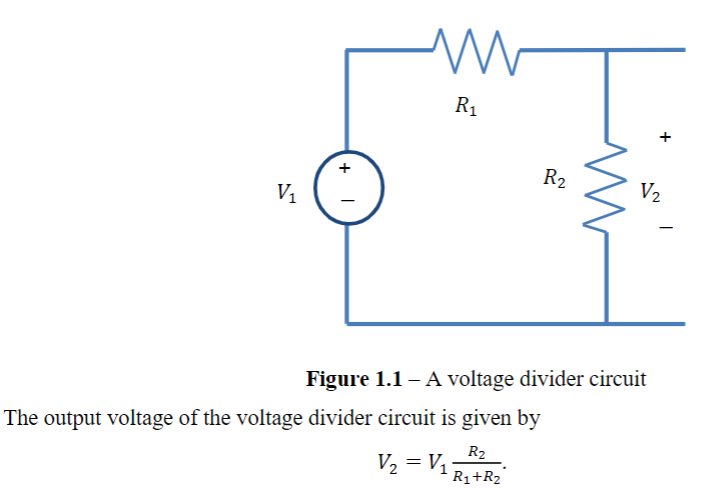Suppose we construct a voltage divider circuit as shown in Figure 1.1 where the voltage source V₁ is a 9Volt battery. Furthermore, we will implement resistor R₁ using two terminals of a 10k pot so that R₁ is variable over the range 0 ≤ R₁ ≤ 10kſ. Find the largest value of the resistor R₂ that will allow the output voltage to vary over a range that includes at least 1.5V ≤ V₂ ≤ 5. OV. Show how you arrived at this value. Then, choose a resistor (or combination of resistors) from your parts kit that will get you as close as possible to (but no larger than) your calculated value for R₂.
Suppose we construct a voltage divider circuit as shown in Figure 1.1 where the voltage source V₁ is a 9Volt battery. Furthermore, we will implement resistor R₁ using two terminals of a 10k pot so that R₁ is variable over the range 0 ≤ R₁ ≤ 10kſ. Find the largest value of the resistor R₂ that will allow the output voltage to vary over a range that includes at least 1.5V ≤ V₂ ≤ 5. OV. Show how you arrived at this value. Then, choose a resistor (or combination of resistors) from your parts kit that will get you as close as possible to (but no larger than) your calculated value for R₂.
Introductory Circuit Analysis (13th Edition)
13th Edition
ISBN:9780133923605
Author:Robert L. Boylestad
Publisher:Robert L. Boylestad
Chapter1: Introduction
Section: Chapter Questions
Problem 1P: Visit your local library (at school or home) and describe the extent to which it provides literature...
Related questions
Question

Transcribed Image Text:V₁
+
I
www
R₁
The output voltage of the voltage divider circuit is given by
R₂
V₂ = V₁R₁+R₂°
R2
V₂
Figure 1.1 - A voltage divider circuit

Transcribed Image Text:Suppose we construct a voltage divider circuit as shown in Figure 1.1 where the voltage source
V₁ is a 9Volt battery. Furthermore, we will implement resistor R₁ using two terminals of a 10k
pot so that R₁ is variable over the range 0 ≤ R₁ ≤ 10k№. Find the largest value of the
resistor R₂ that will allow the output voltage to vary over a range that includes at least
1.5V ≤ V₂ ≤ 5.0V. Show how you arrived at this value. Then, choose a resistor (or
combination of resistors) from your parts kit that will get you as close as possible to (but
no larger than) your calculated value for R₂.
Expert Solution
This question has been solved!
Explore an expertly crafted, step-by-step solution for a thorough understanding of key concepts.
This is a popular solution!
Trending now
This is a popular solution!
Step by step
Solved in 3 steps with 3 images

Knowledge Booster
Learn more about
Need a deep-dive on the concept behind this application? Look no further. Learn more about this topic, electrical-engineering and related others by exploring similar questions and additional content below.Recommended textbooks for you

Introductory Circuit Analysis (13th Edition)
Electrical Engineering
ISBN:
9780133923605
Author:
Robert L. Boylestad
Publisher:
PEARSON

Delmar's Standard Textbook Of Electricity
Electrical Engineering
ISBN:
9781337900348
Author:
Stephen L. Herman
Publisher:
Cengage Learning

Programmable Logic Controllers
Electrical Engineering
ISBN:
9780073373843
Author:
Frank D. Petruzella
Publisher:
McGraw-Hill Education

Introductory Circuit Analysis (13th Edition)
Electrical Engineering
ISBN:
9780133923605
Author:
Robert L. Boylestad
Publisher:
PEARSON

Delmar's Standard Textbook Of Electricity
Electrical Engineering
ISBN:
9781337900348
Author:
Stephen L. Herman
Publisher:
Cengage Learning

Programmable Logic Controllers
Electrical Engineering
ISBN:
9780073373843
Author:
Frank D. Petruzella
Publisher:
McGraw-Hill Education

Fundamentals of Electric Circuits
Electrical Engineering
ISBN:
9780078028229
Author:
Charles K Alexander, Matthew Sadiku
Publisher:
McGraw-Hill Education

Electric Circuits. (11th Edition)
Electrical Engineering
ISBN:
9780134746968
Author:
James W. Nilsson, Susan Riedel
Publisher:
PEARSON

Engineering Electromagnetics
Electrical Engineering
ISBN:
9780078028151
Author:
Hayt, William H. (william Hart), Jr, BUCK, John A.
Publisher:
Mcgraw-hill Education,